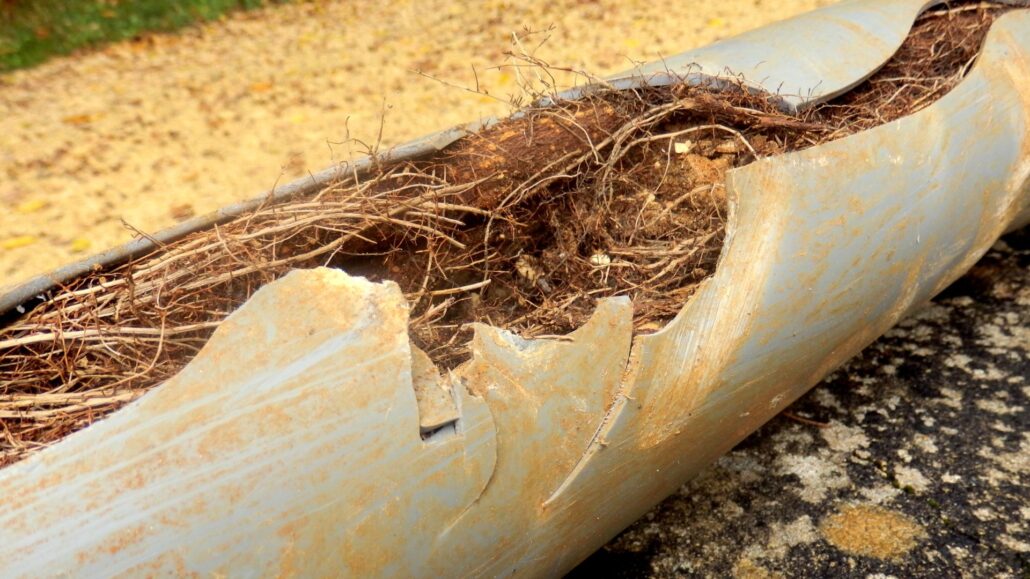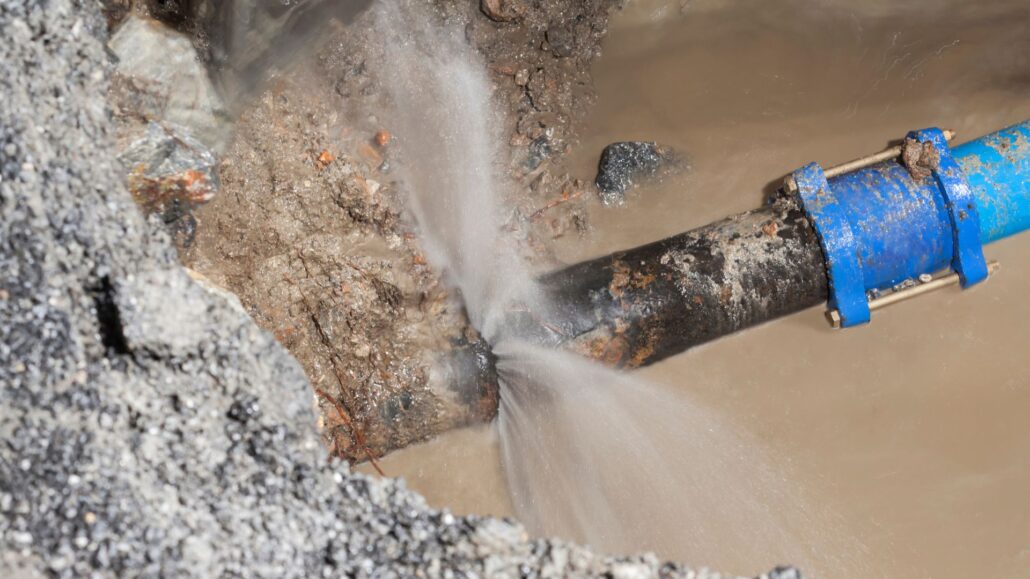Tree roots seeking moisture can easily infiltrate sewer lines, causing significant plumbing issues. This common problem, known as root intrusion, often affects sewer pipes and can disrupt the normal flow of sewage systems.
Over time, the growing roots can lead to severe damage, including blocked and broken pipes. Traditional methods of removing roots typically involve significant excavation, which can be disruptive and costly.
However, trenchless technology offers a less invasive solution to address tree root infiltration in sewer systems effectively. Techniques such as pipe relining and hydrojetting are employed to clear tree roots and repair damaged sewer lines without the need for extensive digging.
This introduction to trenchless solutions highlights a viable option for restoring flow and maintaining the integrity of existing pipes, ensuring the smooth operation of sewer systems with minimal landscape disruption.
Why Does Tree Root Infiltration Happen?

Tree roots naturally seek out moisture and nutrients, often finding a rich source within sewer systems. When roots enter a sewer line through loose joints or small cracks, they thrive in a nutrient-rich environment. This process is termed root intrusion. As these roots grow, they can expand and exert pressure on the pipe walls, causing further damage, such as cracks or burst pipes.
This root growth can lead to several plumbing problems. Initially, small roots grow into drain pipes and sewage lines, which may result in reduced flow and recurrent blockages.
Over time, the roots can become large enough to cause significant damage, requiring extensive sewer pipe repair or even pipe replacement. Root blockages in sewer systems cause inconvenience and can lead to severe damage, warning signs of which include gurgling sounds from drain lines.
Removing tree roots typically involves mechanical cutting tools, hydrojetting with high-pressure water jets, or chemical root killers like copper sulphate, all of which aim to restore flow and maintain the pipe’s integrity.
However, these methods might only temporarily deter root regrowth. Root barriers and regular maintenance by a professional plumber are recommended to provide long-term solutions and control root invasion.
In addition, trenchless solutions such as pipe lining and pipe bursting offer less disruptive methods to repair damaged sewer lines and prevent future root intrusions, thereby safeguarding the sewer system from the havoc roots can wreak.
Overview of Trenchless Technology
Trenchless technology offers a sophisticated approach to repairing and maintaining underground pipes, including sewage lines, without the need for extensive excavation. This technology comprises several methods, each suited to different conditions and requirements.
One popular method is pipe relining, also known as cured-in-place pipe (CIPP) lining. This technique involves inserting a resin-coated liner into the existing pipe, which is then cured to form a robust, new pipe within the old one. This method is particularly effective for repairing damaged sewer lines without disturbing the surrounding area.
Pipe bursting is another trenchless method used primarily to replace severely damaged pipes. It involves pulling a new pipe through the old one and simultaneously fracturing the old pipe outward. This technique is suitable for situations where the existing pipe is beyond simple repair and must be completely replaced.
Hydro jetting is employed to remove roots and clear blockages caused by roots in sewer systems. High-pressure water jets cut through and remove roots, ensuring the smooth flow of the sewage line without the need to excavate the pipes.
These trenchless methods contrast sharply with traditional excavation approaches, which typically involve digging up large sections of land to access and repair or replace the underground infrastructure. Traditional methods can be more disruptive, time-consuming, and environmentally damaging, affecting everything from road traffic to local ecosystems.
Trenchless technology, in comparison, offers a less intrusive option. It reduces the impact on the environment, causes minimal disruption to the public and property, and can be more cost-effective in the long term. Plus, it allows for more precise root control and the preservation of the tree’s root system, which is often inadvertently damaged with excavation methods. This makes trenchless technology a practical choice and a considerate approach to urban infrastructure management.
Benefits of Trenchless Solutions
Environmental Advantages
Trenchless technology stands out for its gentle approach to the environment compared to traditional methods of sewer repair. It preserves the natural landscape and minimises ecological disruption. In urban settings, extensive digging can damage mature tree roots and disturb habitats.
Trenchless methods, such as pipe relining and the installation of root barriers, protect tree roots from damage while preventing future tree root intrusion, thus conserving the surrounding ecosystem.
Reduced Disruption
The non-invasive nature of trenchless repairs means less surface disruption, allowing daily community activities to proceed uninterrupted. Traditional methods often lead to prolonged road closures, dust, and noise. In contrast, trenchless techniques such as hydrojetting to remove tree roots are executed with minimal surface disturbance, maintaining road and property integrity.
Cost Implications and Long-Term Benefits
Although the initial investment in trenchless methods might be higher, the long-term financial benefits are considerable. Techniques like pipe relining enhance the durability of sewer pipes, decreasing the frequency of necessary repairs and lowering long-term maintenance costs for sewer systems. This approach also reduces the reliance on physical barriers and chemical treatments for controlling root growth in sewer lines, further cutting future expenses.
Trenchless technology helps preserve existing pipes through minimal excavation methods, such as careful root cutting and pipe relining. This approach avoids the extensive costs linked to damage repair from traditional excavation, including landscape and structural restoration.
The streamlined maintenance process offered by trenchless methods ensures more efficient and cost-effective management of infrastructure.

How to Implement Trenchless Solutions
Initial Assessment and Diagnostic Technology
The first step in implementing a trenchless solution is conducting a professional assessment. Specialists use advanced diagnostic tools like CCTV cameras to inspect the sewer lines. This technology allows them to visually identify issues such as root entry, blockages, or damage within the drain pipes.
Understanding the specific condition of the sewer system is crucial for selecting the appropriate trenchless method.
Choosing the Right Trenchless Technique
Once the preliminary assessments are complete, the next step is choosing the most suitable trenchless technique. If the CCTV reveals cracked or damaged sewer lines with root invasions, methods such as pipe relining or pipe bursting may be recommended.
Pipe relining is ideal for restoring flow and sealing against further root entry without removing the existing pipe. For more severely damaged sewer lines, pipe bursting might be necessary, especially if larger roots have caused significant structural damage.
Implementation Process
The selected trenchless method is then implemented. For pipe relining, a resin-saturated liner is inserted into the drain line and cured in place, forming a new pipe within the old one. This process repairs the damaged sewer line and prevents the remaining roots from penetrating the new pipe.
In pipe bursting, a bursting head breaks apart the old pipe while simultaneously pulling a new one into place.
Continuous Monitoring and Proactive Maintenance
After the trenchless solution is in place, continuous monitoring is essential to ensure the integrity of the sewer system. Regular inspections help detect potential problems before they wreak havoc. Proactive maintenance, including periodic cleaning and root cutting, helps maintain the effectiveness of the trenchless repairs and prevents future complications.
This comprehensive approach, combining professional assessments, advanced diagnostics, and carefully selected trenchless techniques, ensures a successful and sustainable resolution to common sewer line problems.

Next Steps in Innovation: Looking Ahead
Advancements in Trenchless Technology
The future of trenchless technology promises exciting advancements that focus on enhancing efficiency and reducing environmental impact. One trend is the development of more sophisticated diagnostic tools that provide even greater accuracy in identifying issues within drain pipes. For instance, innovations like AI-powered robots can predict potential failures in sewer systems before they occur, enabling preemptive repairs.
Another area of advancement is the improvement of materials used in pipe relining. Researchers are experimenting with new resin formulas that cure faster and offer improved durability and resistance to root systems. This development not only speeds up the repair process but also extends the lifespan of sewer infrastructure.
The Role of Cutting-Edge Techniques
Emerging techniques in the cutting process are set to revolutionise how roots are managed within sewer systems. Laser cutting and ultrasonic root cutting are becoming more refined, offering precise and less invasive options for cutting roots that intrude into sewer lines. These technologies ensure that the integrity of the drain pipe is maintained while effectively restoring flow.
Additionally, the integration of real-time data collection systems, such as sensors in the downstream manhole, will allow for continuous monitoring of sewer conditions. This technology enables immediate responses to changes in the sewer environment, preventing backups and other issues.
Encouragement for Ongoing Education
For these innovations to be effectively integrated, ongoing education and training for professional plumbers are crucial. Awareness programs and training workshops should be encouraged, providing professionals with the latest knowledge and skills in trenchless technology. This enhances the service quality and ensures that the benefits of these advanced methods are fully realised.
As trenchless technology continues to evolve, it remains essential for industry professionals to stay informed about new techniques and materials. This commitment to education and awareness will drive the successful adoption of future innovations, ensuring sustainable and efficient sewer maintenance solutions.
Secure Your Pipes, Preserve Your Yard
Trenchless technology offers a superior approach to managing sewer line repairs with minimal disruption to your yard. This method protects the landscape and efficiently addresses issues like tree root infiltration before they cause severe damage.
Techniques such as pipe relining strengthen sewer systems and prevent future root entry, ensuring long-term property health and safety.
For reliable trenchless solutions, talk to The Brisbane Plumbers. We specialise in assessing and implementing these innovative methods. Contact us today to safeguard your property’s infrastructure and maintain the beauty of your landscape.
